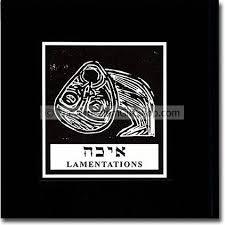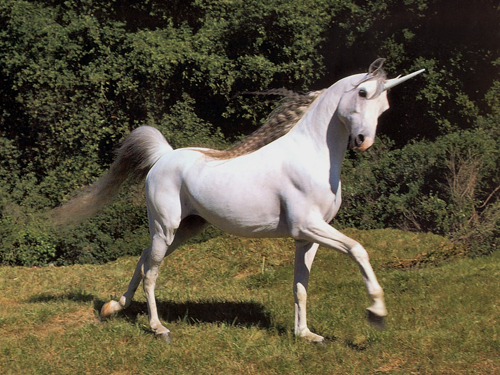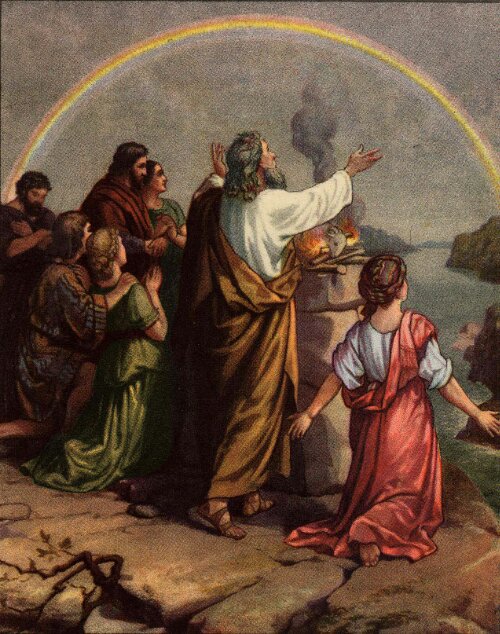You read that right. Yesterday I wrestled with unicorns…all afternoon. And not just your run of the mill mythic Greek unicorns. No. I wrestled with the Biblical variety. In case you have no clue what I’m talking about, you might be surprised to find that “unicorns” are mentioned in the Bible (or at least in the King James Version of the Bible). [1]
Here are the passages where “unicorn/s” are referred to: Numbers 23:22; 24:8; Deuteronomy 33:17; Job 39:9; Psalm 22:21; 29:6; 92:10; and Isaiah 34:7. This is quite a list. I know I was surprised by it.
Perhaps you are actually wondering why I would be concerned about “unicorns” (the Hebrew is רְאֵ֖ם or r’m) in the Bible and spend my afternoon studying them? Well, as it turns out, I have a friend who is a professor in Canada who emailed me an extended question on the topic, because someone had asked him about it. Here is part of his question (where he is citing the person who brought it to him):
“Psalm 92:10 is very clearly saying that this animal has one horn, while Deut. 33:17 is clearly saying that this animal has two horns. Therefore, whatever the r’em is, it must be an animal that could have either one or two horns.”
As such, this individual believes that the “wild ox” translation of most of our modern versions is actually misleading and inaccurate and we should be sticking with the LXX (KJV) rendering of rhinoceros/unicorn.
And here is my reply:
Technically Psalm 92.10 (or more specifically the MT 92.11) only refers to “the horn” of the r’m. This does not require it to have only one horn, but only notes “the horn” of this creature as if to specify a type rather than delineate the number of horns this creature has normally. For instance, I could refer to something being “like the tusk of the elephant” but this does not mean that elephants only normally have one tusk, but I would be referring to the general category, or exemplar of just one of the tusks of the elephant. I could be wrong and perhaps the plural form for “horns” in Deut.33.17 is intended to refer to multiple horns or to the significance of the horn of this creature, but it seems more likely in that case to actually be referring to multiple horns on the single r’m.
On the NIDOTTE [2], it doesn’t have ANY mention of this term as a synonym or anything. Too bad really. And the TWOT doesn’t have anything besides “wild ox”. 🙁
The Black Obelisk [3] also contains images of monkeys (?) and elephants (on another side of it). These are the only two of the four sides depicted in ANEP. However, on yet another side there are what appear to be some sort of an ox and a buffalo and in their middle is a one-horned ox-like creature also being brought as tribute to Shalmaneser (this is a photo from the British Museum: http://www.flickr.com/photos/fuzitalondon/320861479/). So PERHAPS it is a reference to a one-horned creature, but there does not appear to be anything requiring such. Not sure what to think about it. If only there were actually a depiction with a cognate term used so that potentially one might know what is being referred to precisely.
The cognate occurs in Ugaritic r’m : rum “buffalo” UT 49:VI:18, plural rumm (UT 51:I:44; 62:19; 2 Aqhat VI:21 [where his “sinews” are considered “splendid”). For more contemporary citation references: 4.i.44 (in the land of Ym’an there are 10 thousands of them); 5.i.17 (captivated by a pool of water much like the appetite of lions in the wasteland, or the desire of dolphins with the sea and hinds with springs of water), 6.vi.18 (the brutality of the battle between Mot and Baal is compared to the goring of this creature) in Gibson who provides the gloss “wild ox”. [4]
Interestingly enough EVERY occurrence in the Hebrew Bible is in a poetic statement. Not sure what that might mean, but it is interesting nevertheless.
My likeliest explanation for “unicorn” is it derives from the Vulgate [5] which translated the LXX which started with “one-horned”. Not sure where the LXX derives this from, other than potentially their own understanding of the Psalm passage about the singular “horn” of this creature. Granted (as is witnessed on the Obelisk) there is some sort of creature known to the ANE which had a single horn (or so it appears as such), but this does not necessitate the same creature for the Hebrew r’m.
So that is the gist of my wrestling with unicorns in the Bible. However, the story isn’t quite complete, because when I arrived home my oldest daughter (Abbi, 11) showed me a video that her sixth grade class had made which was based on the topic they had been discussing yesterday…which just happened to have been “unicorns”. 🙂 Coincidence…you be the judge. 🙂
__________________________________
[1] Wild ox or buffalo seems to be the preferred translation in many other versions.
[2] He had asked about the New International Dictionary of Old Testament Theology and Exegesis (5 vols; Zondervan, 1997). I also looked at the Theological Wordbook of the Old Testament ()2 vols.; Moody, 1980) which is why I mention it next.
[3] In one of the commentaries he had consulted there was mention made that the Black Obelisk had a picture of a one-horned creature along with other livestock, but sadly that particular side of the Obelisk is not pictured in James Pritchard’s The Ancient Near East: An Anthology of Texts and Pictures (2 vols.; Princeton, 1971). So I included a link to it as photographed in the British Museum.
[4] UT refers to Cyrus Gordon’s Ugaritic Textbook: Grammar, Texts in Transliteration, Cuneiform Selections, Glossary, Indices (Analecta Orientalia 38, Pontificium Institutum Biblicum, 1965). The Gibson text I refer to is Canaanite Myths and Legends (2nd Edition; New York: T&T Clark, 2004). While I did not mention it in my response, one also finds a cognate in the Aramaic and, yet earlier, Assyrian rimu.
[5] The Latin Vulgate translates with the English equivalents of “unicorn” and “rhinoceros”. This appears to be following the Greek Septuagintal translations (LXX).










